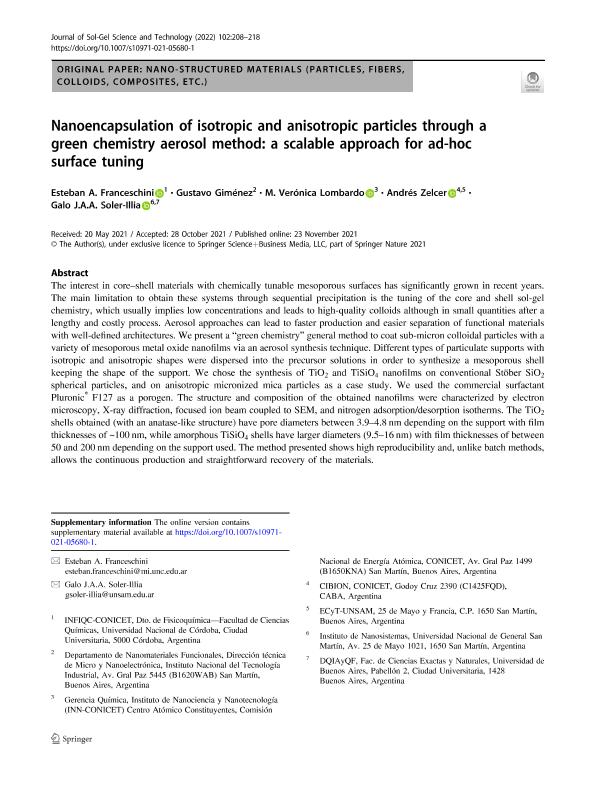Mostrar el registro sencillo del ítem
dc.contributor.author
Franceschini, Esteban Andrés

dc.contributor.author
Giménez, Gustavo
dc.contributor.author
Lombardo, Maria Veronica

dc.contributor.author
Zelcer, Andrés

dc.contributor.author
Soler Illia, Galo Juan de Avila Arturo

dc.date.available
2023-01-03T13:29:03Z
dc.date.issued
2021-11
dc.identifier.citation
Franceschini, Esteban Andrés; Giménez, Gustavo; Lombardo, Maria Veronica; Zelcer, Andrés; Soler Illia, Galo Juan de Avila Arturo; Nanoencapsulation of isotropic and anisotropic particles through a green chemistry aerosol method: a scalable approach for ad-hoc surface tuning; Springer; Journal of Sol-Gel Science and Technology; 102; 1; 11-2021; 208-218
dc.identifier.issn
0928-0707
dc.identifier.uri
http://hdl.handle.net/11336/183137
dc.description.abstract
The interest in core–shell materials with chemically tunable mesoporous surfaces has significantly grown in recent years. The main limitation to obtain these systems through sequential precipitation is the tuning of the core and shell sol-gel chemistry, which usually implies low concentrations and leads to high-quality colloids although in small quantities after a lengthy and costly process. Aerosol approaches can lead to faster production and easier separation of functional materials with well-defined architectures. We present a “green chemistry” general method to coat sub-micron colloidal particles with a variety of mesoporous metal oxide nanofilms via an aerosol synthesis technique. Different types of particulate supports with isotropic and anisotropic shapes were dispersed into the precursor solutions in order to synthesize a mesoporous shell keeping the shape of the support. We chose the synthesis of TiO2 and TiSiO4 nanofilms on conventional Stöber SiO2 spherical particles, and on anisotropic micronized mica particles as a case study. We used the commercial surfactant Pluronic® F127 as a porogen. The structure and composition of the obtained nanofilms were characterized by electron microscopy, X-ray diffraction, focused ion beam coupled to SEM, and nitrogen adsorption/desorption isotherms. The TiO2 shells obtained (with an anatase-like structure) have pore diameters between 3.9–4.8 nm depending on the support with film thicknesses of ~100 nm, while amorphous TiSiO4 shells have larger diameters (9.5–16 nm) with film thicknesses of between 50 and 200 nm depending on the support used. The method presented shows high reproducibility and, unlike batch methods, allows the continuous production and straightforward recovery of the materials.
dc.format
application/pdf
dc.language.iso
eng
dc.publisher
Springer

dc.rights
info:eu-repo/semantics/openAccess
dc.rights.uri
https://creativecommons.org/licenses/by-nc-sa/2.5/ar/
dc.subject
AEROSOL PROCESSING
dc.subject
CORE–SHELL
dc.subject
MESOPOROUS MATERIALS
dc.subject
SILICA
dc.subject
TITANIA
dc.subject.classification
Nano-materiales

dc.subject.classification
Nanotecnología

dc.subject.classification
INGENIERÍAS Y TECNOLOGÍAS

dc.title
Nanoencapsulation of isotropic and anisotropic particles through a green chemistry aerosol method: a scalable approach for ad-hoc surface tuning
dc.type
info:eu-repo/semantics/article
dc.type
info:ar-repo/semantics/artículo
dc.type
info:eu-repo/semantics/publishedVersion
dc.date.updated
2022-10-27T16:52:11Z
dc.journal.volume
102
dc.journal.number
1
dc.journal.pagination
208-218
dc.journal.pais
Alemania

dc.journal.ciudad
Berlin
dc.description.fil
Fil: Franceschini, Esteban Andrés. Consejo Nacional de Investigaciones Científicas y Técnicas. Centro Científico Tecnológico Conicet - Córdoba. Instituto de Investigaciones en Físico-química de Córdoba. Universidad Nacional de Córdoba. Facultad de Ciencias Químicas. Instituto de Investigaciones en Físico-química de Córdoba; Argentina
dc.description.fil
Fil: Giménez, Gustavo. Instituto Nacional de Tecnologia Industrial. Gerencia Operativa de Desarrollo Tecnologico E Innovacion. Sub Gerencia Areas del Conocimiento. Direccion Tecnica de Micro y Nanotecnologias. Departamento Nanomateriales Funcionales.; Argentina
dc.description.fil
Fil: Lombardo, Maria Veronica. Consejo Nacional de Investigaciones Cientificas y Tecnicas. Oficina de Coordinacion Administrativa Ciudad Universitaria. Unidad Ejecutora Instituto de Nanociencia y Nanotecnologia. Unidad Ejecutora Instituto de Nanociencia y Nanotecnologia - Nodo Constituyentes | Comision Nacional de Energia Atomica. Unidad Ejecutora Instituto de Nanociencia y Nanotecnologia. Unidad Ejecutora Instituto de Nanociencia y Nanotecnologia - Nodo Constituyentes.; Argentina
dc.description.fil
Fil: Zelcer, Andrés. Consejo Nacional de Investigaciones Científicas y Técnicas. Oficina de Coordinación Administrativa Parque Centenario. Centro de Investigaciones en Bionanociencias "Elizabeth Jares Erijman"; Argentina
dc.description.fil
Fil: Soler Illia, Galo Juan de Avila Arturo. Universidad Nacional de San Martin. Instituto de Nanosistemas; Argentina. Consejo Nacional de Investigaciones Científicas y Técnicas; Argentina
dc.journal.title
Journal of Sol-Gel Science and Technology

dc.relation.alternativeid
info:eu-repo/semantics/altIdentifier/doi/https://doi.org/10.1007/s10971-021-05680-1
Archivos asociados
